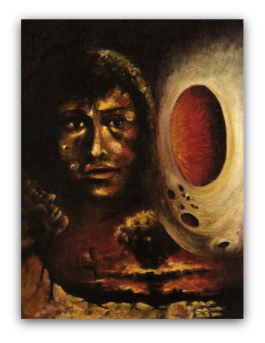For Kalifa Qattan, Cubism, which he used to paint with during the late 1950s, was limiting his vision. Qattan wanted to express deep philosophical, political or humanitarian subjects, but the static and abstract nature of Cubism prevented him from doing that. That is why Qattan drifted away from all the current art schools of that time and came up with his own theory which he called Circulism.
To simplify the concept of circulism it's properties can be looked at from two perspectives; as a painting 'style' and as 'theory'.
Circulism, as the name implies, relies on the circular and curved lines. Qattan avoided straight lines by all means, especially in the early and mid stages of Circulism. The curved line for Qattan served as a signifier for time, motion, evolution and change.
Circulism uses strong and fast brush or knife-strokes of intense pure or semi-pure pigments. Using pure pigments gave Qattan the advantage of getting hues in the highest possible value, and Qattan tried to avoid loosing the saturation of the colour for his own reasons. His aim was beyond using colours to naturally describe the elements in his painting, colour for him served as a tool to add a symbolic merit to those elements.
As concept or theory, Circulism relies on the imagination and produces works which represents dream-like visuals, but unlike what could be called the ‘hallucinatory dreams’ of Surrealism, Circulism deals with and takes inspiration from real-life drama and the struggle of the human soul. In other words, it could be said that Circulism is a Realistic concept. To explain what is meant by Realism, I should say that Qattan, through his work, dealt with political, social, cultural and even feminist issues, unlike the main trend of the twentieth century which was moving towards abstract art.
To simplify the concept of circulism it's properties can be looked at from two perspectives; as a painting 'style' and as 'theory'.
Circulism, as the name implies, relies on the circular and curved lines. Qattan avoided straight lines by all means, especially in the early and mid stages of Circulism. The curved line for Qattan served as a signifier for time, motion, evolution and change.
Circulism uses strong and fast brush or knife-strokes of intense pure or semi-pure pigments. Using pure pigments gave Qattan the advantage of getting hues in the highest possible value, and Qattan tried to avoid loosing the saturation of the colour for his own reasons. His aim was beyond using colours to naturally describe the elements in his painting, colour for him served as a tool to add a symbolic merit to those elements.
As concept or theory, Circulism relies on the imagination and produces works which represents dream-like visuals, but unlike what could be called the ‘hallucinatory dreams’ of Surrealism, Circulism deals with and takes inspiration from real-life drama and the struggle of the human soul. In other words, it could be said that Circulism is a Realistic concept. To explain what is meant by Realism, I should say that Qattan, through his work, dealt with political, social, cultural and even feminist issues, unlike the main trend of the twentieth century which was moving towards abstract art.
